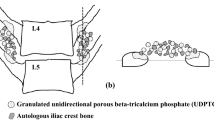Abstract
Previous studies have shown that zoledronic acid administration can increase mineral content and strength in distraction osteogenesis. Of the few studies that have examined the use of bisphosphonates in spinal arthrodesis, none have assessed the effect of single dose treatment. The objective of this study was to evaluate the feasibility of enhancing spinal fusion rate using single dose zoledronic acid (ZA) to increase fusion-mass size and mineral density. Forty-eight New Zealand white rabbits underwent an L6–L7 intertransverse process fusion. The L6–L7 model is more challenging than the more commonly used level of L5–L6. Animals were randomly allocated to one of three groups, one received iliac crest bone graft alone, one group received iliac crest bone graft with locally administered zoledronic acid, 20 μg, and one group received iliac crest bone graft with a single dose of systemically administered zoledronic acid, 0.1 mg/kg. ZA doses were administered at the time of surgery. Twenty-four rabbits were culled at 6 weeks and 24 rabbits were culled at 12 weeks. Success of spinal fusion was determined by manual palpation. Specimens were evaluated radiographically, underwent quantitative computerised tomography analysis and were tested biomechanically in flexion and extension. In the six-week group, only five of the 24 spines fused with no noticeable trend with respect to treatment. In the 12-week group there was a trend toward increased fusion in the systemically administered ZA group (63%) versus the other two groups (25%) but was not statistically significant (p = 0.15). Radiographically, the local ZA treatment group showed a delay in remodelling with the presence of unremodelled bone chips. The 12-week systemic ZA group exhibited an 86% increase in BMC, a 31% increase in vBMD and a 41% increase in the volume of the fusion-mass (p < 0.05). The 12-week local ZA group also showed significant increases in BMC (69%), vBMD (31%) and total fusion-mass volume (29%) (p < 0.05). Biomechanical testing showed that the range of motion in flexion decreased to 4.5 (±2.5) degrees and 4.8 (±4.7) degrees for the local and systemic groups respectively compared to 9.6 (±4.9) degrees for the control group (p < 0.05). This study has shown that zoledronic acid increased fusion-mass size and bone mineral content. Systemic ZA led to an increased fusion rate; however the fusion rate remained below 100%. We suggest that bisphosphonate treatment may require an anabolic conjunctive therapy to ensure enhanced successful fusion.




Similar content being viewed by others
References
Amanat N, Brown R, Bilston LE, Little DG (2005) A single systemic dose of pamidronate improves bone mineral content and accelerates restoration of strength in a rat model of fracture repair. J Orthop Res 23:1029–1034
Babat LB, McLain R, Milks R, Ferrara L, Sohn MJ (2005) The effects of the antiresorptive agents calcitonin and pamidronate on spine fusion in a rabbit model. Spine J 5:542–547
Bae H, Yee A, Friess D, Yoo J, Johnstone B (2002) Alendronate influences bone volume in rabbit posterolateral spine fusion. Spine J 2:98–99
Boden S, Schimandle J, Hutton W (1995) An experimental lumbar intertransverse process spinal fusion model. Spine 20:412–420
Emery SE, Brazinski MS, Koka A, Bensusan JS, Stevenson S (1994) The biological and biomechanical effects of irradiation on anterior spinal bone grafts in a canine model. J Bone Joint Surg Am 76:540–548
Frost H (2003) Bone’s mechanostat: a 2003 update. Anat Rec A Discov Mol Cell Evol Biol. 275A:1081–1101
Grauer JN, Patel TC, Erulkar JS, Troiano NW, Panjabi MM, Friedlaender GE (2001) 2000 young investigator research award winner. Evaluation of OP-1 as a graft substitute for intertransverse process lumbar fusion. Spine 26:127–133
Lee C, Dorcil J, Radomisli T (2004) Nonunion of the spine: a review. Clin Orthop 419:71–75
Lehman R, Kuklo T, Freedman B, Cowart J, Mense M, Riew K (2004) The effect of alendronate sodium on spinal fusion: a rabbit model. Spine J 4:36–43
Little DG, Cornell MS, Hile MS, Briody J, Cowell CT, Bilston L (2001) Effect of pamidronate on distraction osteogenesis and fixator-related osteoporosis. Injury 32:SD-14–SD-20
Little DG, McDonald M, Bransford R, Godfrey CB, Amanat N (2005) Manipulation of the anabolic and catabolic responses with OP-1 and zoledronic acid in a rat critical defect model. J Bone Miner Res 20:2044–2052
Little DG, Smith NC, Williams PR, Briody JN, Bilston LE, Smith EJ, Gardiner EM, Cowell CT (2003) Zoledronic acid prevents osteopenia and increases bone strength in a rabbit model of distraction osteogenesis. J Bone Miner Res 18:1300–1307
Reid I, Brown J, Burckhardt P, Horowitz Z, Richardson P, Trechsel U, Widmer A, Devogelaer J, Kauffman J, Jaeger P, Body J, Meunier P (2002) Intravenous zoledronic acid in postmenopausal women with low bone mineral density. N Engl J Med 346:653–661
Riggs B, Parfitt A (2005) Drugs used to treat osteoporosis: the critical need for a uniform nomenclature based on their action in bone remodeling. J Bone Miner Res 20:177–184
Acknowledgements
The authors would like to thank Dr Richard Appleyard and Ronald Ho from SpineMed for their assistance in use of mechanical testing equipment.
Author information
Authors and Affiliations
Corresponding author
Rights and permissions
About this article
Cite this article
Bransford, R., Goergens, E., Briody, J. et al. Effect of zoledronic acid in an L6–L7 rabbit spine fusion model. Eur Spine J 16, 557–562 (2007). https://doi.org/10.1007/s00586-006-0212-y
Received:
Revised:
Accepted:
Published:
Issue Date:
DOI: https://doi.org/10.1007/s00586-006-0212-y




